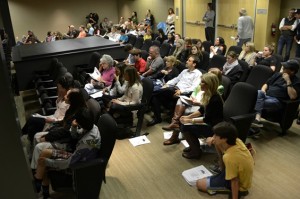Communication, trust and transparency became central themes during the public comment portion of the Santa Monica-Malibu Unified School District Board of Education Meeting on Thursday, March 20, at Malibu City Hall.
The Malibu City Council Chambers filled near its capacity with Malibu residents concerned about the District’s handling of the polychlorinated biphenyl (PCB) contamination affecting Malibu schools.
More than two hours were devoted to discussing the issue, although it was not on the Board’s agenda for that night.
The contention resulting from the issue has strained, if not tainted, relations between Malibu parents and the District. In the past, Malibu residents have criticized the District’s handling of the issue in terms of lacking in proper communication and transparency, as well as the scope of testing proposed to be performed.
“The keys to success are full-scale testing, full transparency and real-time communication,” said Matt DeNicola, a Malibu parent, during his public comment time. “This is 2014: I can find out when the bus isn’t going to be on time, but I can’t figure what’s going on with the high school toxin
levels.”
DeNicola also criticized the District’s spending of $500,000 on the issue, saying, “we are in no better place than we were in October of 2013.”
To date, the District has entered into an agreement with environmental engineering firm Environ International Corporation to develop a testing and cleanup plan, under the oversight of the California Department of Toxic Substances Control, but a plan or timeline has yet to be developed.
“I’m talking to Environ about getting that plan done and we are working with the EPA and the DTSC, so please know that if we could test right now and have a plan, we would do it,” SMMUSD superintendent Sandra Lyon said. “One of the things we’ve heard from the community is to make sure it’s thorough, and we are doing that.”
Jennifer DeNicola – who served as a parent representative on the Malibu Schools Environmental Task Force that originally investigated the PCB contamination issue at Malibu High School – criticized what she said was the District’s lack of urgency regarding the issue.
“It took them about two months to make a contract, [with Environ] and that’s two months of our kids and teachers going to school and nothing getting done,” she said. “I’m upset about the timeline and the fact that there’s no transparency or sense of urgency.”
Jennifer also used her public comment time to convey that Malibu Unites, a newly formed nonprofit advocacy group, wished to hire its own third-party remediation contractor that would work with the District, Environ and the DTSC to assist in the planning, testing and cleanup procedures.
It’s a move that Jennifer said could rebuild lost trust between parents and the District by ensuring the accuracy and diligence of testing and cleanup. “The only way [the District] can rebuild trust is to get an independent expert that represents the parents and teachers,” Jennifer said. “Having somebody that is advocating for our position, to ensure everything is done accurately and it’s done properly and comprehensively is vital to building trust and knowing our schools are safe.”
Board member Laurie Lieberman – defending Lyon and the District – said parents, a teacher and a scientist working for the City of Malibu were included in the interview panel that selected Environ, and said she felt claims of a lack of transparency were without merit.
“This was a very transparent process, and the group came to an agreement to hire this particular firm [Environ],” Lieberman said. “I want you all to be reassured that the process has been transparent and the concerns about that, I think, shouldn’t exist and are somewhat disingenuous.”
Lieberman also called for an end to “allegations of conspiracy and incompetence” directed at Lyon and the District, which she said are “unfounded and border on slanderous and libelous . . . they’re simply not getting us anywhere and aren’t helping us create a transparent, collaborative and communicative process.”
Lieberman, however, suggested the District review its communication processes, especially in terms of how it reacts to toxic contamination issues that may arise at its other schools. “While we have followed policy here and have followed what is required in the state . . . I think we should at least look at and examine those requirements and see if we should have some other kind of requirements for notification,” she said.
Chris Bashaw, Assistant Editor




